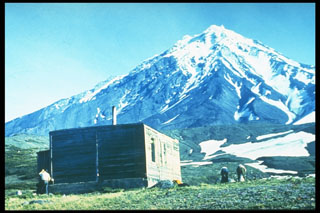Report on Koryaksky (Russia) — April 1994
Bulletin of the Global Volcanism Network, vol. 19, no. 4 (April 1994)
Managing Editor: Richard Wunderman.
Koryaksky (Russia) Seismicity returns to background levels; alert status lowered
Please cite this report as:
Global Volcanism Program, 1994. Report on Koryaksky (Russia) (Wunderman, R., ed.). Bulletin of the Global Volcanism Network, 19:4. Smithsonian Institution. https://doi.org/10.5479/si.GVP.BGVN199404-300090
Koryaksky
Russia
53.321°N, 158.712°E; summit elev. 3430 m
All times are local (unless otherwise noted)
The increased level of seismicity . . . continued to be recorded beneath the volcano (1-2 earthquakes/day) through the end of April. These high-frequency tectonic events (with some unusual characteristics) occurred at 2-12 km depth with a maximum magnitude of 2. This type of event at this depth range has not been identified since the present seismic net on the volcano was installed in 1982. Although the seismic activity continued into early May at a rate of 1-2 earthquakes/day, the lack of additional increase led to the downgrading of the Level of Concern Color Code back to Green.
Seismicity beneath the Koryaksky-Avachinsky area increased above background levels in mid-May to a rate of 6-9 earthquakes/day. During a 2-day period, 18 earthquakes were detected at ~12 km (11 May) and 0-9 km depth (12 May). Seismicity had returned to background levels by 26 May.
Geological Summary. The large symmetrical Koryaksky stratovolcano is the most prominent landmark of the NW-trending Avachinskaya volcano group, which towers above Kamchatka's largest city, Petropavlovsk. Erosion has produced a ribbed surface on the eastern flanks of the 3430-m-high volcano; the youngest lava flows are found on the upper W flank and below SE-flank cinder cones. Extensive Holocene lava fields on the western flank were primarily fed by summit vents; those on the SW flank originated from flank vents. Lahars associated with a period of lava effusion from south- and SW-flank fissure vents about 3900-3500 years ago reached Avacha Bay. Only a few moderate explosive eruptions have occurred during historical time, but no strong explosive eruptions have been documented during the Holocene. Koryaksky's first historical eruption, in 1895, also produced a lava flow.
Information Contacts: V. Kirianov, IVGG.

